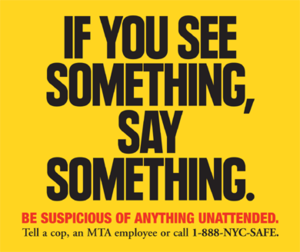Security crowdsourcing"Somethings" may be clogging counterterrorism efforts
Initiatives by DHS to encourage sports fans, shoppers, and public transportation users to “Say Something” if they notice suspicious activity may be overwhelming the system and hindering our defenses, according to a policy analyst; the recent partnership between DHS and the NBA shows DHS does not plan on holding back its call for vigilance

MTA "See something, say something" poster // Source: mta.info
Initiatives by DHS to encourage sports fans, shoppers, and public transportation users to “Say Something” if they notice suspicious activity may be overwhelming the system and hindering our defenses, according to a policy analyst. The recent partnership between DHS and the NBA shows DHS does not plan on holding back its call for vigilance.
The partnership between DHS and the NBA was announced 15 February 2011 by DHS Secretary Janet Napolitano to encourage spectators at the All-Star game activities in Los Angeles to report suspicious activity. Napolitano said the idea behind the message is simple: “It’s asking the American people to be vigilant, and to aid local law enforcement.”
- At a news conference, NBA commissioner David Stern stated “”We hope that this partnership will emphasize basically that security is a shared responsibility.” TV monitors and print materials at the event used the 9/11 message which TSA administrator John S. Pistole attributed the thwarted Times Square bombing attempt with (“DHS launches ‘If You See Something, Say Something’ campaign for general aviation” 28 July 2010 HSNW.)
- The “If You See Something, Say Something” advertising campaign, which was originally implemented by New York City’s MTA and funded, in part, by $13 million from DHS’ Transit Security Grant Program, has been expanding with its work with federal, state, local, and private sector partners, as well as the Department of Justice.
David Rittgers, a legal policy analyst for the Cato Institute, said he thinks the national security agencies are overwhelmed with information.
“While there is value in getting a person on the street to be aware and report suspicious activities, you can also create too many false positives,” Rittgers said.
Rittgers said the Federal Bureau of Investigations receives about 700 messages a day, and the National Counterterrorism Center receives about 10,000 pieces of information daily. Clogging the system with even more reports of indiscriminate “suspicious activities” won’t necessarily bring these agencies closer to the information they need to prevent terrorist plots.
“People talk about connecting dots,” he said. “But it’s knowing which dots to connect that has value. …. The commitment to simply collect all the dots might not be as useful as a lot of people would propose.”
The campaign has been launched with the NFL, more than 9,000 federal buildings nationwide, approximately 818 Walmarts, the Mall of America, the American Hotel Lodging Assoc., Amtrak, the Washington Metropolitan Area Transit Authority, and the general aviation industry.
According to a DHS press release, the Department plans to expand the campaign within the coming months with public education materials and outreach tools “designed to help America’s business, communities, and citizens remain vigilant and plan an active role in keeping the country safe.”
